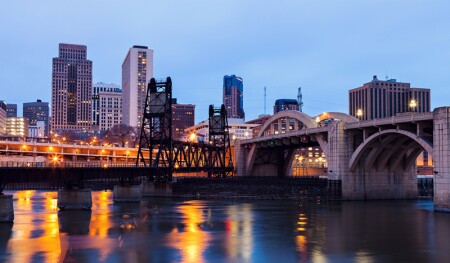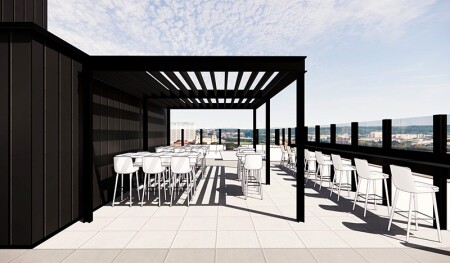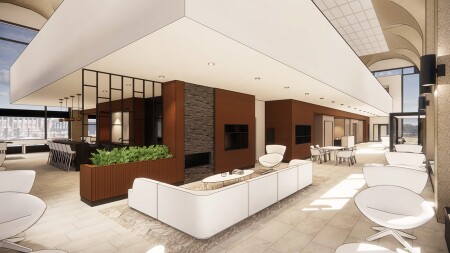Joe Cosenza, vice chairman of Inland Real Estate Group, is the first to admit that he was not overly enthusiastic when presented with the opportunity to buy a vacant office building in St. Paul, Minnesota. The empty structure was a far cry from some of the firm’s past acquisitions in the Twin Cities market, which have included the landmark 57-story IDS Center.
The 386 Wabasha Avenue building was originally erected in 1971 and occupied by service company Ecolab for more than 40 years. The company vacated the 16-story building more than five years ago when it consolidated workers into its new headquarters located down the street. The Wabasha building was bought by a developer in 2018 who planned to convert it to apartments but ended up defaulting on the loan.
When the lender approached Inland about buying the property and moving forward, Cosenza was hesitant, in large part because the firm had never done a conversion of a mid-rise office building before. However, an on-site visit to the property changed his mind. One of the factors that tipped the scales was the location. The building is situated in the heart of downtown St. Paul, and it’s also connected to the St. Paul skyway, the city’s extensive indoor walkway system.
And two, he liked the vision for the conversion laid out by Carl Kaeding, founder and CEO of Kaeding Development Group. Kaeding toured the property with Cosenza and will be serving as the developer on the project. “He showed us what had already been done, and he also shared his vision for the project, which I was completely sold on,” says Joe Cosenza, vice chairman of Chicago-based Inland Real Estate Group and president of Inland Acquisitions. Inland bought the property earlier this year for $17.9 million and is now moving forward with plans to convert the 215,000-square-foot (19,974 sq m) building into 178-unit Class A apartments.
Starting with a Blank Canvas
As noted in the recent Behind the Façade on the feasibility of converting commercial real estate to multifamily published jointly by ULI and the National Multifamily Housing Council, conversion projects are notoriously challenging.
In this case, the building was able to be acquired at a good cost basis and it also had a layout that was suitable for a conversion to residential. The footprint needs to work in a way that you don’t end up with interior, windowless bedrooms, notes Carl Kaeding, founder and chief executive officer of Kaeding Development Group based in Bloomington, Minn. Many commercial office buildings have big floorplates, whereas the Ecolab building has smaller floorplates at roughly 14,000 square feet (1,300 sq m). The central core (e.g. elevators and stairs) allowed for units to be designed around the perimeter wall.
The result was only two interior bedrooms in the entire floorplan, and units have floor-to-ceiling glass with views of the Mississippi River, the Minnesota State Capitol and the Minneapolis skyline. “It’s just a great, great location,” says Kaeding.
Inland and Kaeding Development have been able to hit the ground running as the previous owner had already gutted the interior, put risers in place for utilities and added a second stairway. “Where we’re taking over is that we have a blank palette and we get to paint what we would like on it,” says Kaeding.
The project will include studios, one, two-bedroom and two-bedroom plus den, as well as a variety of amenities such as co-working space, conference rooms and a rentable space on the 16th floor that includes a chef’s kitchen. An indoor pet exercise area also is being added to one of the buildings two below grade levels. “The most notable amenity for this building that is going to sell 90% of the people who walk through the door is a really nice rooftop element,” says Kaeding. The plan is to create an outdoor rooftop lounge with amenities such as grilling stations and firepits.
Conversion Momentum in St. Paul
Inland’s purchase of the Ecolab building is welcome news to the city of St. Paul as it represents a key turning point for the building that has sat empty for the past five years. “We saw it get caught up in a failed redevelopment attempt, and we are now really excited to see somebody come in that has a strong track record. We have every confidence in their ability to deliver that project and bring housing to that corner of downtown St. Paul,” says Joe Spencer, president of the Saint Paul Downtown Alliance.
Although office-to-residential conversions are a hot topic these days amid a growing burden of excess office space, they are by no means a novelty in St. Paul. The CBD has seen a series of office conversions over the past decade. Conversions are playing a key role in helping to remove older, obsolete office buildings from the market and revitalize downtown. Overall, the net inventory of office space in the St. Paul CBD has dropped by more than 1 million square feet (92,903 sq m) over the past decade from 13.5 million square feet (1,254,191 sq m) in 2012 to 12.2 million square feet (1,133,417 sq m) currently, according to Colliers International.
Over the same period, the residential population has doubled over the same period from 5,000 to 10,000, and conversions have been key in creating new housing. Two of the more recent conversions are The Press House Apartments, an income-restricted project that was formerly home to the Pioneer Press newspaper; and the Degree of Honor Building, which is now The Degree, a high-end apartment building. “We believe that converting some of these buildings into residential will make for a more vibrant downtown with more diversity of users across all hours of the day,” says Spencer.
The target completion data for 386 Wabasha is spring 2024, and both Inland and Kaeding Development see more opportunities ahead for office conversions due to changing dynamics in office markets across the country. In fact, Inland is currently looking at two other possible office acquisitions to see if they would be good candidates for a similar conversion.
Where office is robust, conversions simply don’t make sense. However, stress in the office sector is changing the metrics. “I think more of these opportunities will present themselves over the course of the next couple of years while we wash out some of the hospitality and office hangover from COVID,” says Kaeding. “I don’t think these opportunities are here forever, but I do think it is here for the next couple of years.”
More from ULI:





